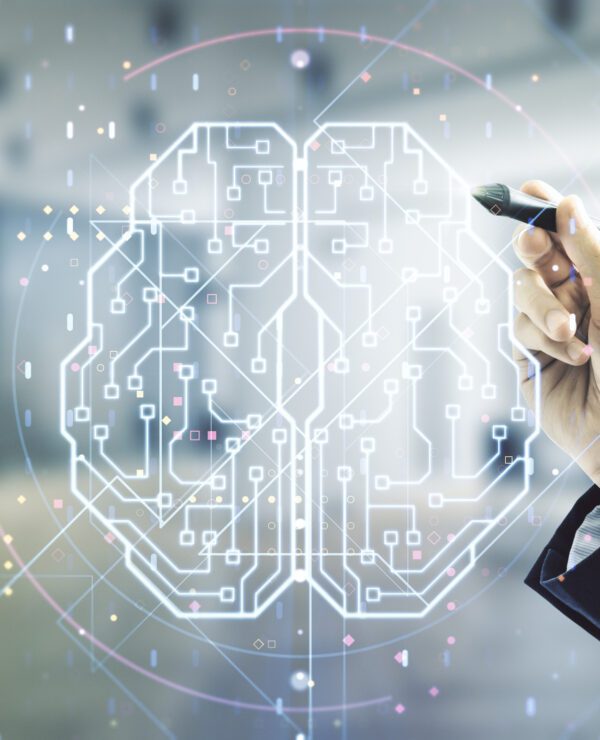Authors
Partner, Intellectual Property, Toronto
Partner, Intellectual Property, Ottawa
Ottawa Managing Partner, Ottawa
Associate, Intellectual Property, Ottawa
Associate, Intellectual Property, Ottawa
Systems for protecting intellectual property (IP) have been in place since the Middle Ages, encouraging skilled, innovative technicians by granting monopolies within particular industries. For hundreds of years, intellectual property policy has been driven by the imperative of rewarding the human creativity or ingenuity that brings new creative works and useful inventions to society, in exchange for disclosure of those works and inventions to further foster progress – the so-called “bargain.”
The advent of machine-learning and modern artificial intelligence (AI) is now challenging this paradigm. Computers have become more powerful and as they acquire higher-order brain function through machine-learning, they have developed the capacity for activity that humans would otherwise consider original or inventive, creating works worthy of copyright protection and inventions worthy of patents. Quantum computers are guaranteed to accelerate this trend.
But who owns these in silico creations? The answer is far from clear, in part owing to the competing policy goals underpinning IP systems. Though IP protection is designed to reward humans for their creativity and ingenuity to foster such behaviour, so too is IP protection designed to advance technological progress irrespective of how it arises. IP statutes are designed by humans for humans – but must it be so?
The past year has brought this issue to the forefront, in the fields of both patent and copyright.
Patents: Can AI be an inventor?
In 2021, we saw the first global court decisions to grapple with whether a nonhuman can be an inventor for the purposes of patent law. A patent application having an AI inventor named DABUS (Device for Autonomous Bootstrapping of Unified Sentience) has been filed in 17 countries. DABUS was created by Dr. Stephen Thaler and he is stated to be the owner of the patent applications. Patent offices have been forced to determine whether a patent can be issued with DABUS as the named inventor. So far, four countries have weighed in, with mixed results.
In July 2021, DABUS scored two wins. First, the South African Patent Office issued a patent listing DABUS as inventor, although no reasoning was provided because South Africa grants patents without substantive examination (and this patent remains subject to court challenge).
Shortly after, the Federal Court of Australia came to the same result under Australian law, explaining that patent law contains no requirement that an inventor be human. The Australian Court was motivated by the need to promote and reward technological innovation, noting that the term “inventor” was undefined and its ordinary meaning (like other agent nouns, such as “computer” or “dishwasher”) does not exclude non-humans. After concluding that DABUS was the inventor, the Court found that Dr. Thaler was the invention’s owner because he derived title from the inventor, DABUS. To reach this result, the Court reasoned that it was not necessary that an inventor be a legal person capable of assigning rights to conclude that an owner’s title has been “derived” from the inventor in accordance with the Australian Patents Act. It will be interesting to see if this rationale justifying the assignment of rights from a non-human inventor to a human assignee will be applied in other jurisdictions.
Courts in the United Kingdom and United States have come to a different conclusion on the inventorship issue. The U.K. Court of Appeal concluded that the character and obligations of an inventor necessitate that they be human. Machines lack legal personality and cannot have rights, nor can they transfer rights to their owners. A machine cannot offer a statement that it is the true inventor of an invention. In the United States, the U.S. District Court for the Eastern District of Virginia pointed to the definition of an inventor in U.S. patent law as being an “individual,” which must be a “natural person” under U.S. law, and to the human-oriented requirement of an inventor to indicate their “belief” regarding their inventorship.
No Canadian authority has yet weighed in on this issue, although as Canadian patent law is modeled most closely on U.S. and U.K. law, it stands to reason that the perspectives in those jurisdictions will carry weight in any future case. However, like in Australia, there is no definition of “inventor” in Canada’s Patent Act.
Copyright: Can AI be an author?
AI also raises novel issues with respect to copyright, including on the question of authorship and ownership of works generated by AI. Under current copyright law in Canada, it is unclear whether AI-generated works are protected by copyright. Copyright protects works that are the product of the exercise of an author’s skill and judgment. The default rule is that the author is the first owner of copyright (subject to certain exceptions). There is no definition of “author” in Canada’s Copyright Act, but copyright jurisprudence suggests that an author must be a natural person.
AI systems are now capable of creating works that are generated – to some degree or even entirely – independent of human intervention. This development challenges established legal doctrine which has understood and defined authorship as an act of expression originating from a human being. Whether AI-generated works are protected by copyright, and if so, who owns legal rights to the work, is an important issue with implications for public policy and the Canadian economy.
In July 2021, the Government of Canada published a consultation paper soliciting submissions on, among other things, a modern copyright framework for AI in Canada. With respect to authorship and ownership of AI-generated works, the consultation paper suggested three possible approaches:
- The first approach is to make entirely AI-generated works ineligible for copyright protection. This approach reflects the state of the law in a number of countries, including Australia, where (unlike for patented inventions) copyright only protects works produced by a human author, not machine-generated works.
- The second approach is to attribute authorship to the human or humans who arranged for the creation of the work (but not to the AI that actually created the work). This approach to AI-generated works has been implemented through legislative changes in several common law jurisdictions, including the United Kingdom, Ireland and New Zealand.
- The third approach is to permit copyright protection of AI-generated works, but to consider them to be “authorless.” Under this approach, presumably no moral rights would attach to AI-generated works, meaning that no individual would have the right to have their name attributed to the work as the author or to preserve the integrity of the work.
While adopting any of the above approaches would help to clarify legal rights to AI-generated works under Canadian law, each one has significant economic and public policy implications. This is particularly the case given the importance of AI in the modern economy and the public interest in promoting AI development and use in Canada. It remains to be seen which approach Canada will adopt.
Implications of increasing recognition of AI-generated IP
Important consequences flow from the decision whether to formally recognize and reward AI-generated creations within intellectual property systems.
If AI-powered service providers cannot protect their creations, they will lack bargaining power in commercial arrangements. In that situation, commercial affairs will need to be structured to involve human contributions as a basis to assert or obtain copyright or patent protection. If patent and copyright systems are seen as inadequate, businesses may also choose to preserve their innovations as trade secrets rather than publicly disclosing their IP. Differences between jurisdictions will complicate these business assessments.
Conversely, if AI-generated creations are eligible for patent or copyright protection, then owners of the most powerful AI will be empowered to seize control of whole areas of IP, potentially triggering an IP arms race, pitting humans against machines. At this early stage, where AI is only occasionally inventive, it is difficult to truly imagine where this empowerment may lead. Canadian IP policy decisions on AI-generated creations are likely to be driven by the desire to attract, rather than deter, investment into AI research and development in Canada. These decisions will demand thoughtfulness and creativity, and (we dare say) a human touch.
chatgpt
chat gpt
openai
open ai


